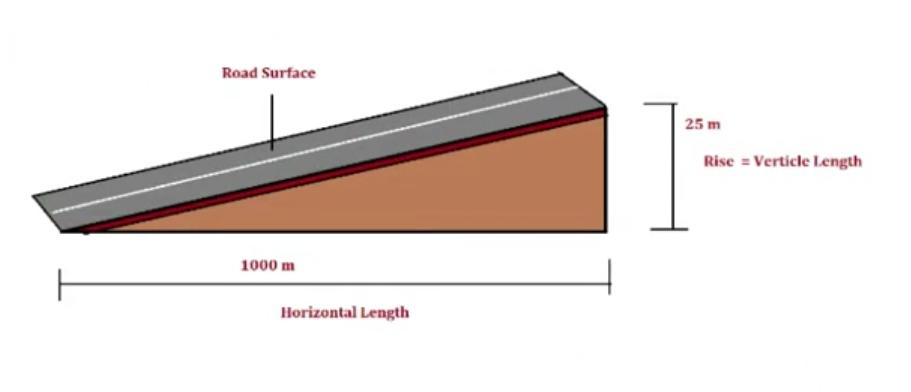What Is the Gradient of Road?
Important Point
It is defined as the rate of rising or falls along the length of the road with respect to the horizontal is known as Gradient of Road.
In another word, it is the longitudinal slope provided to the formation level of the road along its alignment. It is generally expressed in 1 in n ( where 1 is a vertical unit to n is a horizontal unit)
It is also expressed in percentage.
Gradient = (Vertical distance / Horizontal distance) x 100
Also, read:What is Bitumen And Bitumens Types
Purpose of Providing Gradient to the Roads
- To connect the two stations or points with each other, which are located at different levels.
- To provide effective drainage of rainwater, especially when the pavement is provided with the curbs.
- To construct the side drains economically.
- To make the earthwork required for the road construction economic by balancing cutting and filling.
Importance of Gradient in Roads
- The gradient is the most important part of the construction of roads. It is essential to give properly required gradient to the road along the length of its alignment with respect to horizontal.
- Gradient allows movement of the vehicle on the vertical curves smoothly.
- The gradient also helps to drain off rainwater from the surface of the roads.
- Gradients are very helpful on curved roads in flat terrain where drainage problem arises.
- Before finalizing the gradient of the road, it is important that the construction cost, vehicular operation cost, and the practical problems that may arise on the site also have to be considered.
Effect of Gradient on Roads
- The effect of gradient on the vehicular speed is considerable. This is particularly important in roads where the proportion of heavy vehicles is significant.
- Due to less sight distance at uphill gradients, the speed of traffic is generally controlled by these heavy vehicles. Due to which the operating costs of the vehicles are increased, and the capacity of the roads will have to be reduced.
- Due to high speed between heavy and light vehicles, and between uphill and downhill gradient accidents abound in the gradients.
Factors Affecting Gradient
- Nature of the ground.
- Drainage required.
- Nature of the traffic.
- The type of road surface.
- The total height to be covered.
- Road and railway interaction.
- Safety Required.
- Bridge Approaches.
Irc Recommendations for Gradient
IRC had specified desirable values for different types of terrains.
| Detail | Ruling | Limiting | Exceptional |
| Plain or Rolling Area | 1 in 30 | 1 in 20 | 1 in 15 |
| (3.3%) | (5.0%) | (6.7%) | |
| Mountainous Area | 1 in 20 | 1 in 16.7 | 1 in 14 |
| (5.0%) | (6.0%) | (7.0%) | |
| Steep Area | 1 in 16 | 1 in 14.3 | 1 in 12.5 |
| (6.0%) | (7.0%) | (8.0 |
Types of Road Gradient
The types of road gradient are as follows
- Ruling Gradient.
- Limiting Gradient.
- Exceptional Gradient.
- Average Gradient.
- Floating Gradient.
- Minimum Gradient.
1. Ruling Gradient
The gradient, which is usually adopted while making the alignment of the road, is known as the ruling gradient. The ruling gradient is used for designing the road because it gives maximum safety at minimum cost.
2. Limiting Gradient
The gradient, which is steeper than the ruling gradient, is known as the limiting gradient. In some situations, we cannot adopt the ruling gradient, where we have to use a limiting gradient.
It is usually used in hilly terrain and rolling terrain. The topographical condition of a place compels adopting the steeper gradient. It is also known as the maximum gradient.
3. Exceptional Gradient
The gradient, which is steeper than the limiting gradient, is known as the exceptional gradient. This type of gradient is generally used in an extraordinary situation where shorter lengths of the roads are available.
Exceptional gradients are a very steeper gradient that is used in the unavoidable situation like in the mountainous region and terrain. But the drawback of an exceptional gradient is that it required more fuel consumption and has more friction losses.
4. Average Gradient
The total rate of rising or fall between any two points along the alignment of the road divided by the horizontal distance between two points is known as an average gradient.
5. Floating Gradient
The gradient on which a motor vehicle, moving with a constant speed, continues to descend at the same speed without any application of power or brakes is known as a floating gradient.
6. Minimum Gradient
The minimum desirable slope which is essential for the effective drainage of rainwater from the surface of the known as a minimum gradient. It is usually adapt where surface drainage is important.
Gradient of Road
It is the rate of rising or fall of road level along its length. It is expressed either as the rate of rise or fall to the horizontal distance or as percentage rise or fall. In India usually, former practice is used.
Road Gradient Standards
In the United States, maximum grade for Federally funded highways is specified in a design table based on terrain and design speeds, with up to 6% generally allowed in mountainous areas and hilly urban areas with exceptions for up to 7% grades on mountainous roads with speed limits below 60 mph (95 km/h).
Types of Road Gradient
- Linear: When you think of the word gradient, this is likely the concept that comes to mind.
- Radial: In a radial gradient, the colors fan out from the starting point in a circular pattern.
- Angle: An angle gradient sweeps counterclockwise around the starting point.
- Reflected: It’s all in the name.
Ruling Gradient in Road
It is the maximum gradient within which the designer attempts to design the vertical profile of a road. It is also known as design gradient. As per IRC, the recommended value of ruling gradient for plain or rolling terrain is 1 in 30 or 3.3 %.
Exceptional Gradient
Exceptional gradients are very steeper gradients given at unavoidable situations. They should be limited for short stretches not exceeding about 100 metres at a stretch. In mountainous and steep terrain, successive exceptional gradients must be separated by a minimum 100 metre length gentler gradient.
Limiting Gradient
Limiting Gradient: The gradient steeper than the ruling gradient, which may be used for a limited Road length, is called limiting gradient or maximum gradient. It is used where the topography of place compels adopting a steeper gradient than the ruling gradient to minimize the cost of road construction.
Floating Gradient
The gradient on which a motor vehicle moving with a constant speed continues to descend with the same speed without any application of power brakes is called a floating gradient.
Road Gradient
It is the rate of rise or fall of road level along its length. It is expressed either as the rate of rise or fall to the horizontal distance or as percentage rise or fall. In India usually, former practice is used.
Road Gradient Standards
- In the United States, maximum grade for Federally funded highways is specified in a design table based on terrain and design speeds, with up to 6% generally allowed in mountainous areas and hilly urban areas with exceptions for up to 7% grades on mountainous roads with speed limits below 60 mph (95 km/h).
- In the India, The gradient provided on flat or level road to drain off the rainwater is called minimum gradient. It should be sufficient to drain off the rainwater from the pavement surface. In general 1 in 200 gradients is sufficient but for cement concrete surface a grade of 1 in 500 is quite sufficient
Like this post? Share it with your friends!
Suggested Read –
- Road Horizontal
- Curb of the Road
- Building Estimation Step by Step In Excel Sheet
- House Construction Cost Calculator Excel Sheet
- How to Calculate Slab Steel Quantity from Drawing
- House Construction Cost Calculator Excel Sheet For Ground Floor(G.F.), G.F.+1, G.F.+2, G.F.+3,
- How to Excavation Calculation in Excel Sheet | What Is Excavation | Important Point of Excavation as per IS Code
Originally posted 2023-05-10 15:47:26.









Leave a Reply